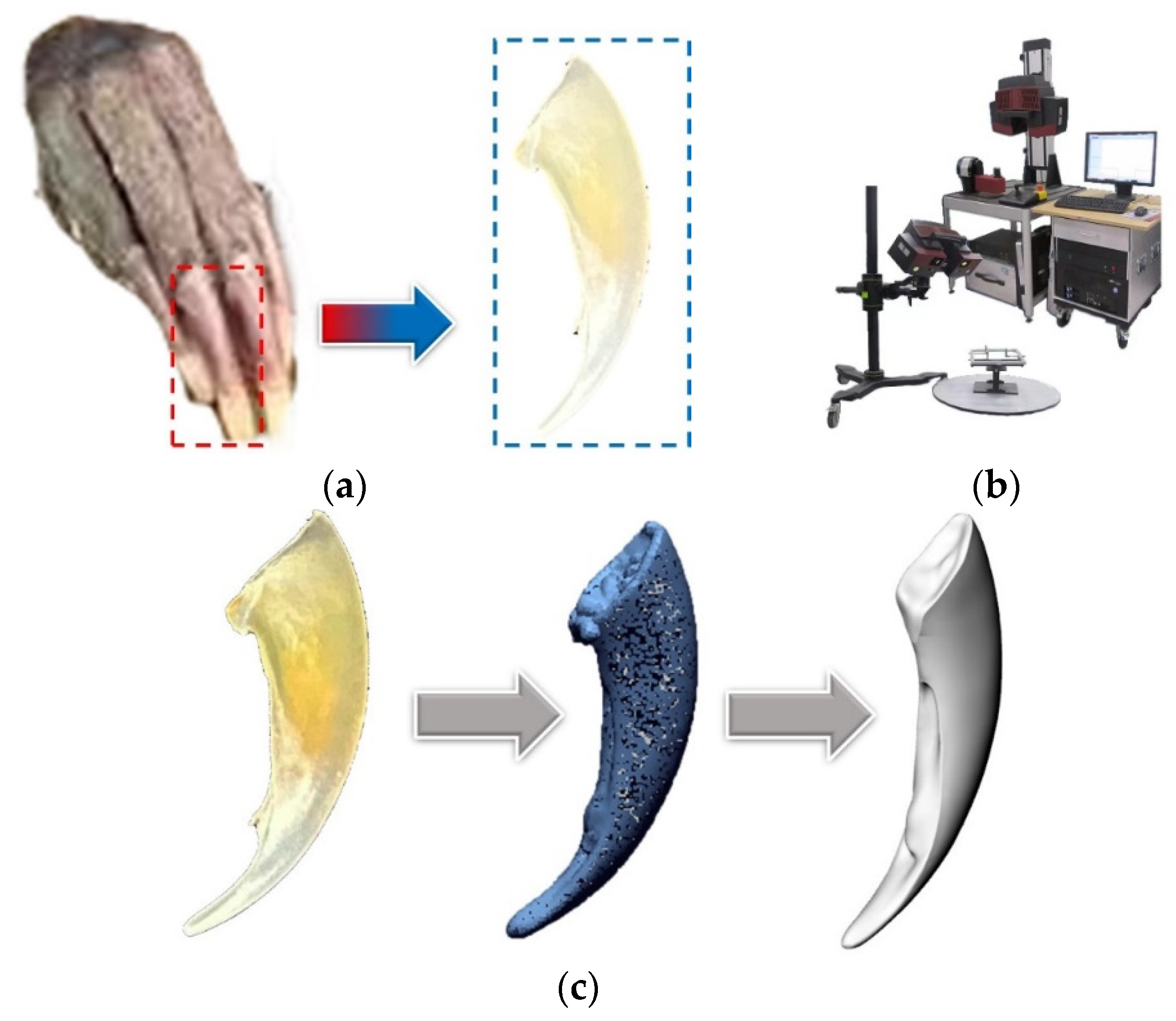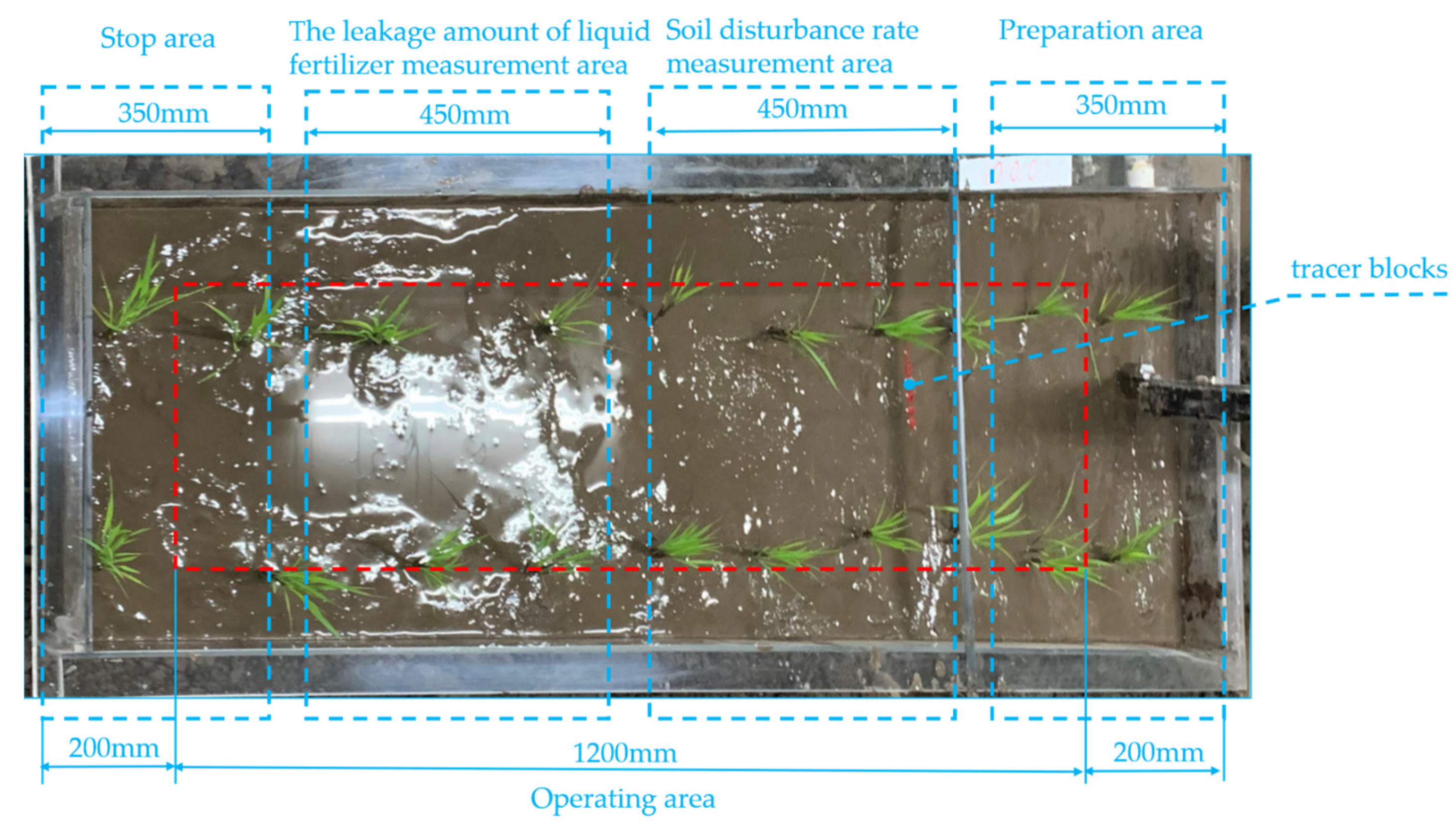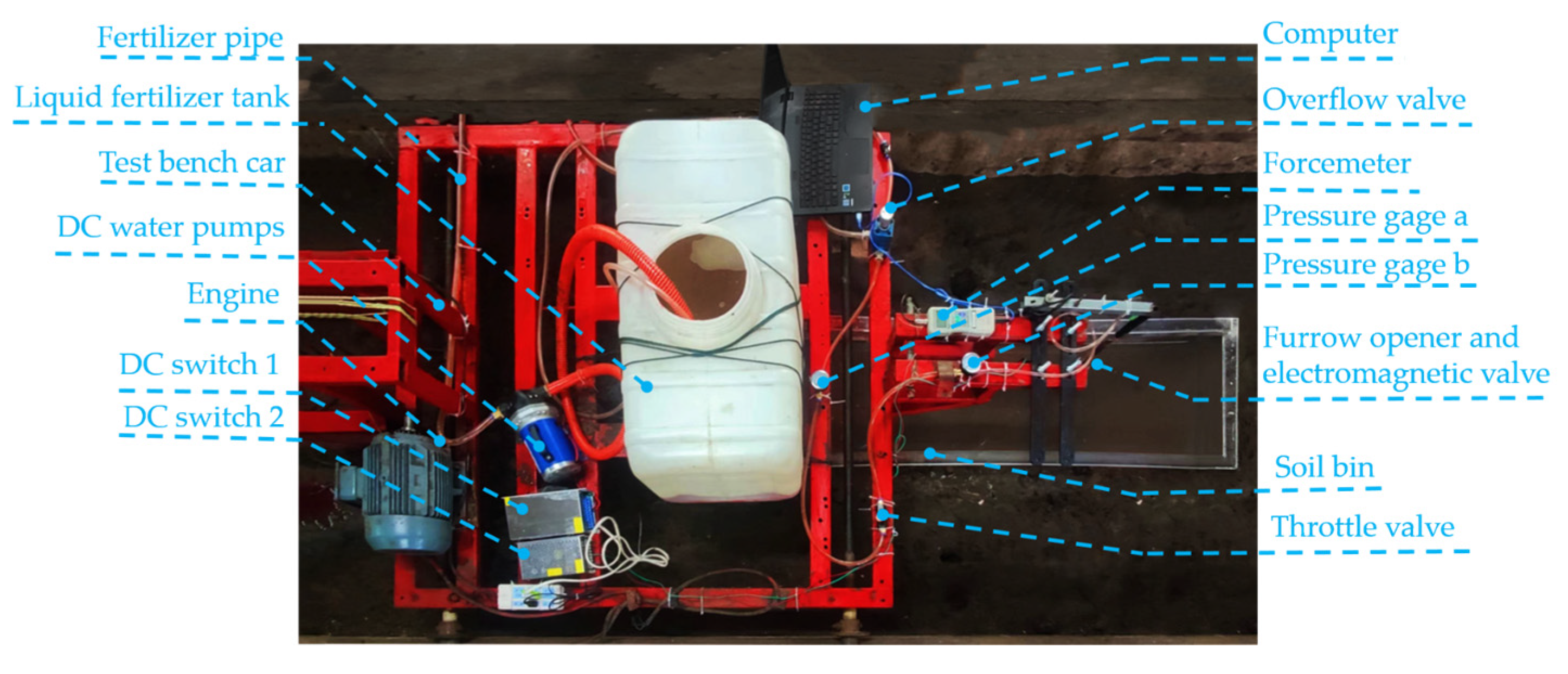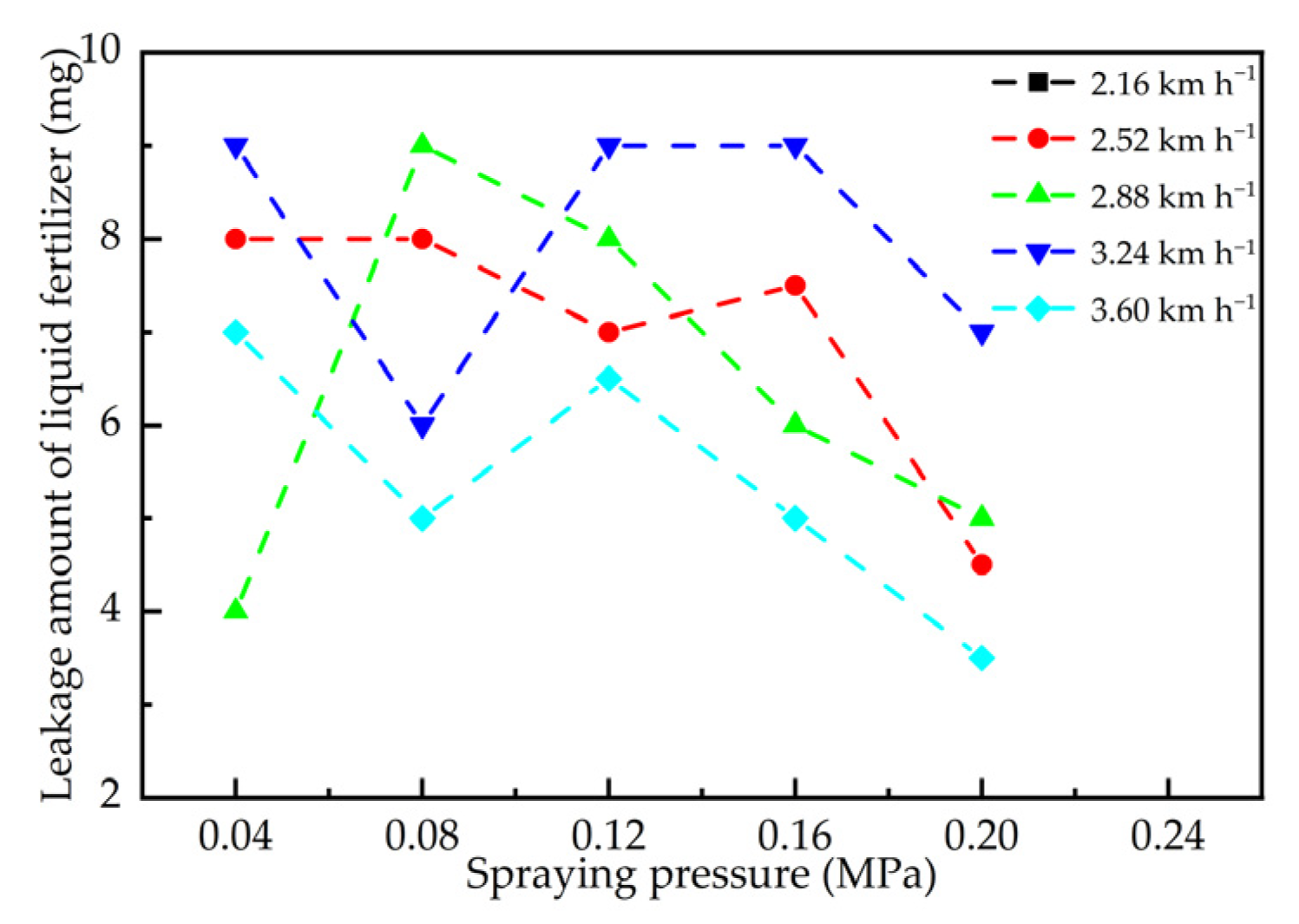Bionic Design of Furrow Opener Based on Muskrat Claw-Toe Structure to Improve the Operating Performance of Deep Application of Liquid Fertilizer in Paddy Fields in Cold Region of China
Abstract
1. Introduction
2. Materials and Methods
2.1. Shape Design of the Bionic Liquid Fertilizer Deep Application Furrow Opener
2.1.1. Extraction of Bionic Prototype
2.1.2. Design of the Bionic Liquid Fertilizer Deep Application Furrow Opener
2.2. Indoor Soil Bin Tests
2.2.1. Soil Bin Construction
2.2.2. Soil Bin Test Design
- Furrowing resistance P
- Soil disturbance rate ρ
- Liquid leakage amount of fertilizer amount V
2.3. Indoor Soil Bin Test Design
3. Results and Discussion
3.1. The Effect of Operating Speed on Furrowing Resistance
Analysis of Furrowing Resistance at Different Speeds
3.2. The Effect of Operating Speed on the Gully Profile and Soil Disturbance Rate
Soil Backfilling Rate at Different Speeds
3.3. The Effect of Operating Speed and Liquid Fertilizer Spraying Pressure on the Leakage Amount of Liquid Fertilizer
Leakage Amount of Fertilizer under the Same Pressure and Different Speeds
4. Conclusions
Author Contributions
Funding
Institutional Review Board Statement
Data Availability Statement
Acknowledgments
Conflicts of Interest
References
- Hu, Z.; Tian, Y.; Xu, Q. Review of Extension and Analysis on Current Status of Hybrid Rice in China. Hybrid Rice 2016, 31, 1–8. [Google Scholar]
- Mao, C.; Wan, Y.; Ma, G.; Shi, Y.; Zhou, X.; Song, Z.; Han, S.; Xie, L.; Wei, S. Current Status Analysis of Hybrid Rice Development in China. Hybrid Rice 2006, 21, 1–5, 53. [Google Scholar]
- Shan, L.; Huang, Q. The Construction of Grain Strategic Base: The Guarantee of my country’s Grain Security. J. Acad. Exch. 2009, 183, 111–114. [Google Scholar]
- Yang, W.; Zhang, P. Effect of liquid amino acid fertilizer on rice. J. North Rice 2018, 48, 30–33. [Google Scholar]
- Wang, D.; Pei, L. Present situation and protection measures of black soil resources in Northeast China. Agric. Technol. 2021, 41, 100–102. [Google Scholar]
- Chou, J.; Zhuang, W.; Liang, R. Development and analysis of precision variable fertilizer application technology. Agric. Mach. 2018, 10, 68–71. [Google Scholar]
- Guo, Z.; Chen, H.; Yi, H.; Huang, Z. Analysis and Prospect of Developing Status of Liquid Precise Fertilizing. Xinjiang Agric. Mech. 2021, 2, 35–37. [Google Scholar]
- Alam, M.Z.; Sadekuzzaman, M.; Sarker, S.; Hafiz, M. Reducing soil application of nitrogenous fertilizer as influenced by liquid fertilization on yield and yield traits of kataribhog rice. Int. J. Agron. Agric. Res. 2015, 6, 63–69. [Google Scholar]
- Liu, X.; Wang, H.; Zhou, J.; Chen, Z.; Lu, D.; Zhu, D.; Deng, P. Effect of nitrogen root zone fertilization on rice yield, uptake and utilization of macronutrient in lower reaches of Yangtze River, China. Paddy Water Environ. 2017, 15, 625–638. [Google Scholar] [CrossRef]
- Chen, B. Research on Pneumatic Ejection Type Liquid Fertilizer Deep Application Device in Paddy Field; South China Agricultural University: Guangzhou, China, 2018. [Google Scholar]
- Zhao, S.; Liu, H.; Tan, H.; Cao, X.; Zhang, X.; Yang, Y. Design and performance experiment of opener based on bionic sailfish head curve. Trans. Chin. Soc. Agric. Eng. 2017, 33, 32–39. [Google Scholar]
- Zhang, Z.; Zhang, J.; Zhang, Y. Optimization design of furrow opener based on bionics design. Comput. Integr. Manuf. Syst. 2022, 28, 1143–1149. [Google Scholar]
- Wang, J.; Wen, N.; Liu, Z.; Zhou, W.; Tang, H.; Wang, Q.; Wang, J. Coupled Bionic Design of Liquid Fertilizer Deep Application Type Opener Based on Sturgeon Streamline to Enhance Opening Performance in Cold Soils of Northeast China. Agriculture 2022, 12, 615. [Google Scholar] [CrossRef]
- Sun, J.; Chen, H.; Wang, Z.; Ou, Z.; Yang, Z.; Liu, Z.; Duan, J. Study on plowing performance of EDEM low-resistance animal bionic device based on red soil. Soil Tillage Res. 2020, 196, 104336. [Google Scholar] [CrossRef]
- Xue, W. Design and Research of Bionic Drag Reduction Double Disc Furrow Opener; Jilin University: Jilin, China, 2017. [Google Scholar]
- Miller, J.E. Muskrats; Wildlife Damage Management Technical Series ; USDA, APHIS, WS National Wildlife Research Center: Fort Collins, Colorado, 2018; 13p. [Google Scholar]
- Bautista, E.; Watanabe, E.; Yoda, A.; Hayashi, H.; Koike, M. Deep placement of fertilizer solution in puddled soils Part 1: Nitrogen losses. Trans. ASAE 1999, 42, 623. [Google Scholar] [CrossRef]
- Yan, D. Research on Mechanism and Experiment of Paddy Field Bionic Weeding Device Based on Water Jet; Northeast Agricultural University: Harbin, China, 2021. [Google Scholar]
- Zhou, W. Mechanism Analysis and Experimental Study of Deep Application Inclined Liquid Fertilizer Pothole Fertilization Device; Northeast Agricultural University: Harbin, China, 2018. [Google Scholar]
- Wang, J.; Gao, G.; Weng, W. Design and test of key components of paddy field side deep fertilization device. J. Agric. Mach. 2018, 49, 92–104. [Google Scholar]
- Pan, S.; Mo, Z.; Luo, X. Effects of Mechanical Synchronous Deep Fertilization on Rice Population Quality and Yield. J. Huazhong Agric. Univ. 2013, 32, 1–5. [Google Scholar]
- Zheng, W. Design and Experimental Research on Rice Jet Topdressing Machine; South China Agricultural University: Guangzhou, China, 2019. [Google Scholar]
- Lu, Y. Structural Design and Experimental Research on Rice Jet Fertilizer; South China Agricultural University: Guangzhou, China, 2016. [Google Scholar]
- Zhang, C.; Zhang, Y.; Li, G. Root morphology and Characteristics of physiological change formed by the high yield of rice under lateral deep fertilization. Acta Agron. Sin. 2022, 1–14. Available online: http://kns.cnki.net/kcms/detail/11.1809.S.20220914.1731.005.html (accessed on 17 January 2023).
- Zhang, C.; Fan, X.; Li, M.; Li, G.; Zhao, C.; Sun, W. Simulation analysis and experiment on soil disturbance of chisel ploughing blade based on EDEM. Trans. Chin. Soc. Agric. Mach. 2022, 53 (Suppl. S2), 52–59. [Google Scholar]
- Jiang, X. Design and Research of Drag Reduction Subsoiling Shovel and Detection Device of Tilling Depth Based on Soil Dynamics; Jilin University: Jilin, China, 2021. [Google Scholar]
- Liu Junan, W.X.; Li, H.; He, J.; Wang, Q.; Li, W. Optimization of Structural Parameters of Subsoiling Shovel Based on Soil Disturbance and Traction Resistance. Trans. Chin. Soc. Agric. Mach. 2017, 48, 60–67. [Google Scholar]
- Wang, Y. Research on Opener Resistance Test and Ditching Performance in Paddy Soil Conditions; Nanjing Agricultural University: Nanjing, China, 2012. [Google Scholar]
- Wang, J.; Liu, Z.; Sun, X.; Tang, H.; Wang, Q.; Zhou, W. Design and experiment of target drilling device of deep application type liquid fertilizer. Trans. Chin. Soc. Agric. Mach. 2022, 53, 152–162. [Google Scholar]
- Rodhe, L.; Etana, A.J.B.E. Performance of slurry injectors compared with band spreading on three Swedish soils with ley. Biosyst. Eng. 2005, 92, 107–118. [Google Scholar] [CrossRef]
- Van Der Born, D.; Pees, A.; Poot, A.J.; Orru, R.V.; Windhorst, A.D.; Vugts, D.J. Fluorine-18 labelled building blocks for PET tracer synthesis. Chem. Soc. Rev. 2017, 46, 4709–4773. [Google Scholar] [CrossRef] [PubMed]
- Zhou, W.; Song, C.; Sun, X.; Liu, Z.; Ni, X.; Shen, K.; Wang, Y.J.; Tian, L. Design of High-Efficiency Soil-Returning Liquid Fertilizer Deep-Application Furrow Openers for Improving Furrowing Performance in Cold Regions of Northeast China. Agriculture 2022, 12, 1286. [Google Scholar] [CrossRef]
- Noordwijk, M.v.; Brouwer, G.; Meijboom, F.; Oliveira, R.G.; Bengough, A. Trench profile techniques and core break methods. Root Methods 2001, 211–233. [Google Scholar] [CrossRef]
- Liu, J.; Chen, Y.; Lobb, D.; Kushwaha, R.J.C.B.E. Soil-straw-tillage tool interaction: Field and soil bin study. Can. Biosyst. Eng. 2007, 49, 2. [Google Scholar]
- Russelle, M.P.; Lamb, J.F.; Montgomery, B.R.; Elsenheimer, D.W.; Miller, B.S.; Vance, C.P. Alfalfa rapidly remediates excess inorganic nitrogen at a fertilizer spill site. J. Environ. Qual. 2001, 30, 30–36. [Google Scholar] [CrossRef]
- Lyons-Johnson, D. Novel alfalfa cleans fertilizer spill. Agric. Res. 1997, 45, 14–17. [Google Scholar]
- Zhang, B.; Liu, X.; Xia, Y. Improvement of the method for determining the total nitrogen content of urea. Henan Agric. 2020, 31, 24–25. [Google Scholar]
- Meng, F. Design and Experiment of Sliding Ditching Device; Jilin University: Jilin, China, 2021. [Google Scholar]
- Lu, Y. Design and Experimental Research on High-Speed Bionic Opener; Jilin University: Jilin, China, 2020. [Google Scholar]
- Xiao, P. Application of Calculus in Particle Mechanics. Math. Learn. Res. 2014, 13, 94. [Google Scholar]
- Tian, P. Experiment and Research on Bionic Drag Reduction of Boat-Type Paddy Field Walking Machinery; South China Agricultural University: Guangzhou, China, 2019. [Google Scholar]
- Duan, L. The influence of water flow resistance on the navigation speed of shallow channel ships is analyzed. Ship Sci. Technol. 2018, 40, 13–15. [Google Scholar]
- Ding, Q.; Ge, S.; Re, J.; Li, Y.; He, R. Research on Subsoiling Resistance and Soil Disturbance Effect of Paddy Soil. J. Agric. Mach. 2017, 48, 47–56+63. [Google Scholar]
- Hang, C. Research on Disturbance Behavior of Deep Loose Soil Based on Discrete Element Method; Northwest A&F University: Xianyang, China, 2017. [Google Scholar]
- Tan, H. Design and Experiment of a Combined Seeding Ditcher; Northwest A&F University: Xianyang, China, 2018. [Google Scholar]
- Liu, H.; Han, J.; Chen, J.; Lv, J.; Zhao, S. Performance simulation and experiment on rigid press wheel for hilly area. Nongye Jixie Xuebao/Trans. Chin. Soc. Agric. Mach. 2018, 49, 114–122. [Google Scholar]
- You, X. The Theory Analysis of Furrower Soil Backfilling. Agric. Sci. Technol. Equip. 2014, 11, 37–39. [Google Scholar]
- Zhang, Z.; Zhao, J.; Tang, X.; Sun, C. Imulation of “Submerged” Water jet impact on Soil Based on EDEM-Fluent Coupling. J. Agric. Mech. Res. 2023, 45, 30–36. [Google Scholar]
- Wang, J.; Yan, D.; Wang, Q.; Tang, H.; Zhuo, W. Design and experiment of weeding device between plants in jet-type paddy fields. J. Agric. Mach. 2021, 52, 78–85. [Google Scholar]
- Li, F.; Du, J.; Shi, X. Study on Ground-breaking Mechanism of Jet and its engineering application. Fluid Mach. 1997, 2, 26–29. [Google Scholar]
- He, X.; Sang, Q.; Zheng, F. An Experimental Study on Impact of Multiples Agent Actions on Sloping Water Erosion in Different Mollic Thickness Regions of Northeast China. J. Soil Water Conserv. 2021, 35, 103–109, 115. [Google Scholar]
- Wang, Z.; Chang, G.; Jiang, Q. Constructing pedo-transfer functions based on grey relational and nonlinear programming to estimate hydraulic parameters in black soil. Trans. Chin. Soc. Agric. Eng. 2019, 35, 60–68. [Google Scholar]
- Zhang, L.; Wang, R.; Zhang, C.; Wang, S.; Xu, T. Intelligent irrigation strategy based on regulated deficit theory and fuzzy control for rice in cold region. Trans. Chin. Soc. Agric. Eng. 2016, 32, 52–58. [Google Scholar]














Disclaimer/Publisher’s Note: The statements, opinions and data contained in all publications are solely those of the individual author(s) and contributor(s) and not of MDPI and/or the editor(s). MDPI and/or the editor(s) disclaim responsibility for any injury to people or property resulting from any ideas, methods, instructions or products referred to in the content. |
© 2023 by the authors. Licensee MDPI, Basel, Switzerland. This article is an open access article distributed under the terms and conditions of the Creative Commons Attribution (CC BY) license (https://creativecommons.org/licenses/by/4.0/).
Share and Cite
Zhou, W.; Ni, X.; Song, K.; Wen, N.; Song, C.; Sun, X.; Wang, Y.; Wang, J.; Wang, Q.; Tang, H. Bionic Design of Furrow Opener Based on Muskrat Claw-Toe Structure to Improve the Operating Performance of Deep Application of Liquid Fertilizer in Paddy Fields in Cold Region of China. Agriculture 2023, 13, 254. https://doi.org/10.3390/agriculture13020254
Zhou W, Ni X, Song K, Wen N, Song C, Sun X, Wang Y, Wang J, Wang Q, Tang H. Bionic Design of Furrow Opener Based on Muskrat Claw-Toe Structure to Improve the Operating Performance of Deep Application of Liquid Fertilizer in Paddy Fields in Cold Region of China. Agriculture. 2023; 13(2):254. https://doi.org/10.3390/agriculture13020254
Chicago/Turabian StyleZhou, Wenqi, Xue Ni, Kai Song, Nuan Wen, Chao Song, Xiaobo Sun, Yijia Wang, Jinfeng Wang, Qi Wang, and Han Tang. 2023. "Bionic Design of Furrow Opener Based on Muskrat Claw-Toe Structure to Improve the Operating Performance of Deep Application of Liquid Fertilizer in Paddy Fields in Cold Region of China" Agriculture 13, no. 2: 254. https://doi.org/10.3390/agriculture13020254
APA StyleZhou, W., Ni, X., Song, K., Wen, N., Song, C., Sun, X., Wang, Y., Wang, J., Wang, Q., & Tang, H. (2023). Bionic Design of Furrow Opener Based on Muskrat Claw-Toe Structure to Improve the Operating Performance of Deep Application of Liquid Fertilizer in Paddy Fields in Cold Region of China. Agriculture, 13(2), 254. https://doi.org/10.3390/agriculture13020254











